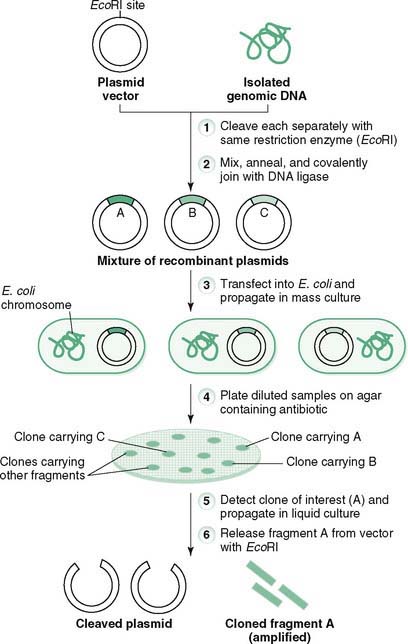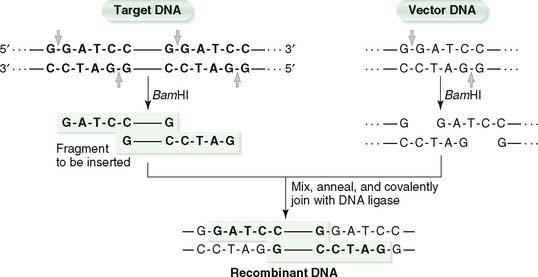Chapter 13 DNA Technology
I. Recombinant DNA and DNA Cloning
A. Overview
1. Cloning is a means of obtaining large quantities of specific DNA fragments (i.e., target DNA) for sequencing, genetic engineering, and expression of the encoded proteins.
2. Target DNA is obtained from genomic DNA by digestion with restriction enzymes or from complementary DNA (cDNA) that is produced from mRNA with reverse transcriptase.
3. Restriction endonucleases produce DNA fragments with complementary (“sticky”) ends that can be rejoined.
4. Cloning vectors are able to recombine with restriction fragments and replicate within a host cell to amplify the target DNA.
5. Vectors may be plasmids that grow within living host cells, phage vectors that destroy the host bacterium after replicating, or larger artificial chromosomes from bacteria and yeast.
6. DNA cloning in plasmids involves growing a host culture containing a mixture of recombinant plasmids and then detecting the target DNA in individual host cells by using probes; the host cells containing the target are then grown to produce large quantities of the target DNA.
C. Genomic DNA and complementary DNA
1. Two methods are commonly used to produce target DNA pieces suitable for cloning: genomic DNA and complementary DNA (cDNA).
a. Genomic DNA is digested with restriction endonucleases producing a mixture of all or part of a particular gene, including introns and other noncoding sequences.
D. Restriction endonucleases
1. Restriction endonucleases are bacterial enzymes that are highly specific for short nucleotide sequences (i.e., restriction sites) and cleave both DNA strands within this region.
2. Staggered cuts are made by most restriction enzymes, producing DNA fragments with single-strand ends.
a. Restriction sites are palindromes; both strands of DNA have the same sequence when read in a 5′ → 3′ direction.
3. DNA fragments from different sources produced by cleavage with the same restriction enzyme and containing complementary sticky ends anneal (i.e., form base pairs) with each other.
E. Cloning vectors
F. Plasmid vectors (Fig. 13-2)
1. Plasmid vectors are constructed from small, circular, extrachromosomal DNAs (i.e., plasmids) that are spontaneously taken up by host bacterial cells.
G. Other vectors
1. Other vectors can hold larger DNA fragments and are more efficient than plasmids in transfecting host cells.
2. Lambda-phage vectors, produced from lambda (λ) bacteriophage, can hold DNA fragments up to 20 kb long.
H. Basic steps in DNA cloning




1. Summary of basic steps in DNA cloning, which are similar for all types of vectors, is depicted in Figure 13-3 for a plasmid vector.
2. Recombinant vectors are transfected into appropriate host cells under conditions that favor incorporation of only one vector per cell.


13-3 Overview of DNA cloning with a plasmid vector. Restriction enzyme digestion of genomic DNA produces multiple fragments with different sequences. Mixing these fragments with cleaved plasmids yields a mixture of recombinant plasmids, each containing a different fragment (e.g., A, B, C). After growth and plating of transfected E. coli cells on antibiotic-containing agar plates, the fragments are separated physically into different clones. A specific fragment of interest can be identified by hybridization with a complementary probe (see Fig. 11-4) and then isolated from the vector.
Stay updated, free articles. Join our Telegram channel

Full access? Get Clinical Tree




